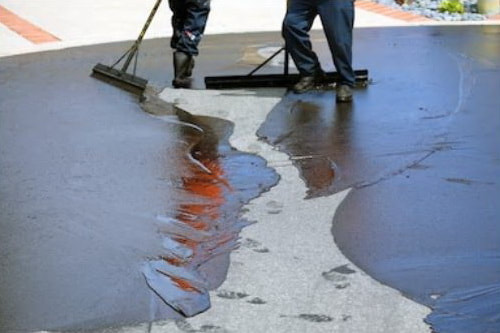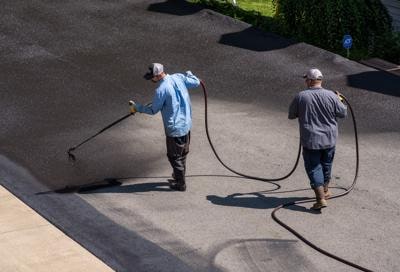Optimize Toughness: Hot Mix Asphalt Sealing for Angled Parking Frameworks
Optimize Toughness: Hot Mix Asphalt Sealing for Angled Parking Frameworks
Blog Article
Hot Mix Asphalt: A Sustainable Remedy for Sidewalk
Warm Mix Asphalt (HMA) has actually become a leading lasting option for pavement services, providing a myriad of environmental benefits and innovative modern technologies. Its capability to recycle materials and reduce energy consumption offers an engaging situation for its adoption in road building and construction tasks. The long-lasting performance and durability of HMA make it a recommended alternative for framework development. As the demand for environmentally friendly construction techniques grows, exploring the subtleties of HMA's sustainability can offer valuable understandings into the future of sidewalk options.
Ecological Benefits of Warm Mix Asphalt

Moreover, Warm Mix Asphalt aids to alleviate urban warmth island impacts. Its dark color absorbs sunshine, decreasing the amount of warm mirrored back into the environment compared to lighter-colored pavements. This can reduce ambient temperature levels in urban areas, lowering the demand for cooling and inevitably reducing power usage.
Additionally, Warm Mix Asphalt adds to enhanced stormwater administration. Its permeable nature enables water to infiltrate the sidewalk and recharge groundwater materials, lowering drainage and the threat of flooding. These ecological benefits make Warm Mix Asphalt a sustainable choice for paving freeways and roadways.
Power Performance in HMA Manufacturing
Is energy efficiency a vital element in the manufacturing of Hot Mix Asphalt (HMA)? Absolutely. Energy plays a considerable role in the manufacturing of HMA, impacting both cost and environmental sustainability. One essential facet of energy performance in HMA manufacturing is using warm mix asphalt (WMA) innovations (commercial parking lot paving). WMA permits the mixing and positioning of asphalt at lower temperature levels compared to typical warm mix asphalt, causing lowered power consumption throughout manufacturing. This process not only reduces gas use yet also decreases greenhouse gas exhausts, making it an extra eco-friendly alternative.
Furthermore, innovations in plant innovations have actually resulted in even more energy-efficient HMA production processes. Modern plants are designed with functions like recycled asphalt pavement (RAP) processing capacities, reliable heater systems, and improved insulation, all contributing to power cost savings. By maximizing energy usage in HMA manufacturing, the sector can lower its carbon footprint while keeping premium pavement materials. Power efficiency is, therefore, an essential factor to consider in guaranteeing the sustainability of Warm Mix Asphalt manufacturing.
Recyclability of Hot Mix Asphalt
The recyclability of Warm Mix Asphalt (HMA) is a crucial aspect of its sustainability and long-term ecological impact. HMA is among the most recycled materials in the United States, with over 100 million lots of reclaimed asphalt pavement (RAP) being reused annually in new sidewalk building and construction. Recycling HMA offers try this out several ecological benefits, such as reducing the requirement for virgin materials, lowering energy usage throughout manufacturing, and lowering the quantity of waste sent out to landfills.
The process of recycling HMA includes grating the existing pavement, crushing it into smaller pieces, and mixing it with new aggregate and asphalt binder to produce a recycled mix. This recycled mix can usually perform as well as or perhaps better than official source traditional HMA, while needing fewer basic materials and creating lower greenhouse gas emissions. By incorporating RAP into new sidewalk tasks, roadway firms can preserve all-natural sources, reduce prices, and lessen the environmental footprint of roadway building and construction and upkeep tasks. Generally, the recyclability of HMA plays a considerable function in promoting sustainable techniques within the sidewalk market.

Long-Term Efficiency of HMA
Asphalt pavements demonstrate sturdiness and durability over an extensive duration, mirroring the lasting efficiency of Warm Mix Asphalt (HMA) The long life of HMA can be credited to its ability to withstand heavy traffic loads, severe weather conditions, and the effects of aging. Studies have revealed that properly designed and effectively created HMA sidewalks can last for two decades or even more with routine maintenance. The key to taking full advantage of the long-lasting performance of HMA lies in making use of high-grade products, complying with finest methods in construction, and implementing effective upkeep methods. Appropriate drainage, regular assessments, and timely repair work are important for maintaining the architectural stability of HMA pavements with time. Furthermore, developments in HMA technology, such as making use of polymer-modified binders and warm mix asphalt, have even more improved the durability and durability of HMA pavements. By prioritizing high quality building and maintenance practices, HMA remains to verify itself as a sustainable and cost-effective service for durable sidewalk framework.

HMA: Toughness and Sustainability
Demonstrating both sturdiness and sustainability, Hot Mix Asphalt (HMA) has come to be a keystone in the building and construction of lasting pavement infrastructures - angled parking. HMA's longevity comes from its capability to stand up to heavy lots, severe weather problems, and high traffic volumes, making it a reputable selection for highways, freeways, and airport paths. The make-up of HMA, which commonly look at here consists of accumulations, binder, and filler, plays an essential function in improving its durability and resistance to tear and wear
Furthermore, HMA's sustainability hinges on its recyclability and energy-efficient manufacturing process. The ability to reuse reclaimed asphalt sidewalk (RAP) in new HMA blends lowers the demand for virgin products and minimizes the ecological influence of pavement building and upkeep. In addition, the energy effectiveness of creating HMA depends on its reduced mixing temperatures compared to various other sidewalk products, bring about decreased energy usage and greenhouse gas discharges.
Conclusion
Finally, warm mix asphalt (HMA) supplies a lasting solution for pavement with its environmentally friendly qualities. HMA's recyclability, energy effectiveness in manufacturing, and long-lasting longevity make it an environmentally friendly choice for road construction. By conserving natural resources, reducing waste, and lowering greenhouse gas exhausts, HMA plays a crucial duty in advertising sustainability in framework growth. Its capability to alleviate metropolitan heat island effects further emphasizes its relevance in creating environmentally mindful and resilient sidewalk systems.
HMA is one of the most recycled materials in the United States, with over 100 million loads of redeemed asphalt sidewalk (RAP) being recycled each year in brand-new pavement building and construction.The process of reusing HMA includes grating the existing pavement, squashing it into smaller sized items, and blending it with brand-new accumulation and asphalt binder to develop a recycled mix.Asphalt pavements demonstrate resilience and durability over a prolonged period, showing the lasting performance of Hot Mix Asphalt (HMA) Additionally, innovations in HMA technology, such as the usage of polymer-modified binders and cozy mix asphalt, have additionally improved the resilience and long life of HMA pavements. The ability to recycle reclaimed asphalt pavement (RAP) in brand-new HMA mixtures lowers the need for virgin materials and minimizes the ecological influence of sidewalk construction and upkeep.
Report this page